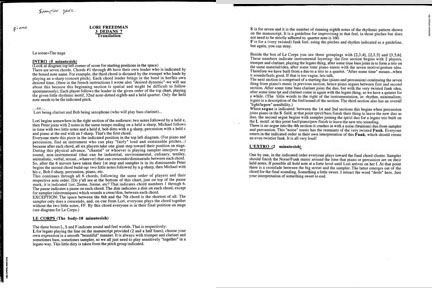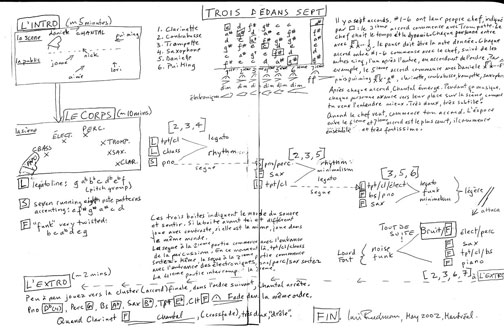
Lori Freedman
3 dedans 7
Listen to 3 dedans 7. Written by Lori Freedmann. First performance: May 4, 2002 at Calixa Lavallée (Parc Lafontaine) by L'Ensemble Canevas. Commissioned by Supermusique. Performed by Nicolas Caloia (Bass), Aimé Dontigny (Trumpet), Joane Hétu (Saxophone), Danielle P. Roger (Percussion), Lee Pui Ming (Piano), Chantal Dumas (Electronics), Lori Freedman (Bass Clarinet).


Trois Dedans Sept (2002) is written for clarinet, saxophone, trumpet, piano, contrabass, percussion, and electronic sampler. It is divided into three sections: “Intro,” “Le Corps” (“The Body”), and “L’Extro” (“The Outro”); hence the meaning of the title – three sections of music for seven players. One of the main features of Freedman’s method of notation in Trois Dedans Sept is that it places the creative emphasis on the exploration of various kinds of musical relationships between the performers, rather than focusing on the pitch and rhythmic material. Freedman explores a number of different relationships, ranging from the alternating “follow-the-leader” dynamic in the “Intro,” to the contrast between consonant and dissonant musical relationships in “Le Corps,” to the juxtaposition of the individual, the sampler DJ, and the group in “Intro” and “L’Extro.”
First Section
The first section, “Intro” is based on a chord progression which is presented as a pitch matrix. This matrix shows both the horizontal and vertical pitch relationships in terms of harmony and voice leading, as well as the instrumentation. “Intro” consists of six phrases corresponding to each chord in the matrix. Lori Freedman structures the phrases according to a “follow-the-leader” dynamic whereby a designated leader indicates the dynamics of a given phrase by playing the first chord tone. The director for a given chord is designated by the chord tone with the square around it. The rest of the musicians then follow in sequence in a similar manner. The electronics part is always the last to enter in a given phrase, interjecting with samples of found sounds of a sustaining quality. The piece begins with the musicians offstage, dispersed throughout the concert space. At the end of each phrase, as the electronic samples crescendo and diminuendo, the musicians take a large step towards the stage so that, by the end of the “Intro,” everyone is onstage to play the final chord tutti and fortissimo.
Second Section
The second section, “Le Corps” (“The Body”), features three contrasting “sound worlds”: “L” for a legato melodic line, “S” for seven running eighth note patterns with certain accented pitches, and “F” for a “twisted funk” style. Each sound world features a distinct set of pitches, rhythms and style. “Le Corps” is divided into four sections indicating different combinations of instruments, as well as combinations of different sound worlds. One instrument from each section segues into the next with the exception of the final section, which interrupts the previous sections with a tutti passage in the “F” sound world performed in a “brutish” way, resulting in very loud and dissonant funky music. Thus, contrary to a conventional understanding of similar and dissimilar musical relationships, the most disruptive moment in the piece occurs when all of the musicians are playing within the same sound world, “F,” as opposed to the previous sections where the players perform in different sound worlds.
Final Section
In the final section, “L’Extro” (“The Outro”), the players gradually make their way to the pitch to which they are assigned in the final sustained pitch cluster. The piece ends with the sampler emerging from the pitch cluster with a sample that Freedman indicates only as “something sweet.”
 English |
English |